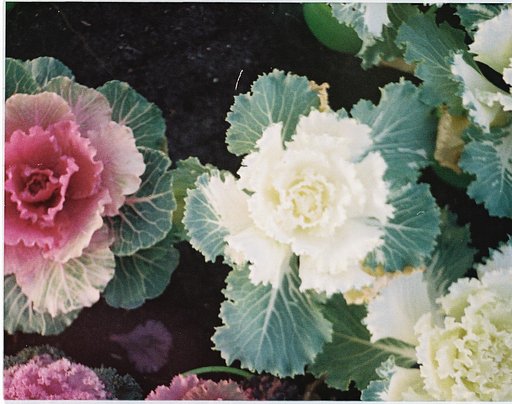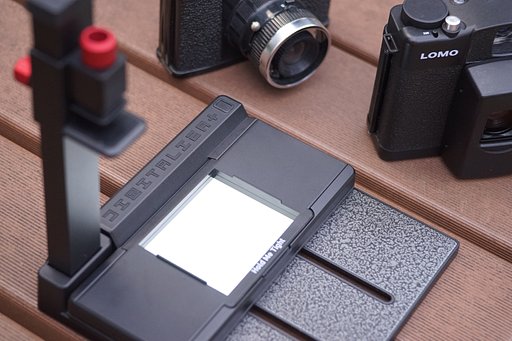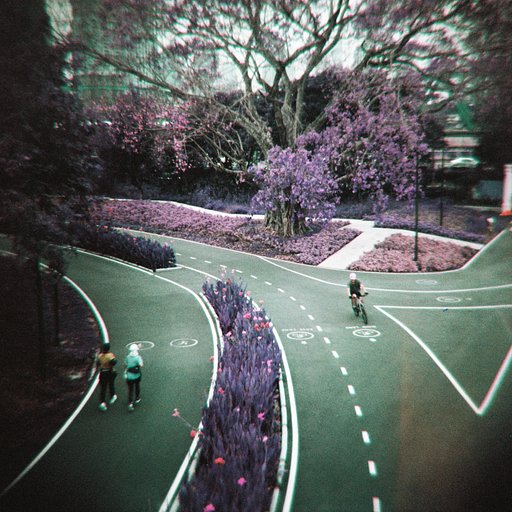On Inspiring Others to Go Analogue — an Interview with Dmitri Tcherbadji
1 14 Share TweetWe have always been fascinated by stories of people in the film community. There's a feeling of camaraderie and kinship between analogue fans that is just so inviting. It draws you in and when you meet a like-minded people with, as they would say, "film developing agent" in their veins, the short introduction becomes a two-hour conversation that touches anything from favorite cameras to admired artists. Photographer Dmitri Tcherbadji is one of those people. He is an enthusiastic and passionate person and it shows in his work whether on words or film photographs. We had the pleasure of talking with him and in this interview, he shares with all of us some of his thoughts and musings about film.

Hi, Dmitri and welcome to the Magazine! Please, introduce yourself to our readers.
My name is Dmitri, I currently live in Vancouver, Canada. I work as a front-end developer and have found a couple of tech companies in the past. I love nature, travel, art, music, rock climbing, and, of course, film photography.
What do you like about film photography?
Film photography helps me disconnect from the fervorous complexity of computer screens. It helps me stay creative and adventurous. It's a fantastic way to experiment and learn. Film taught me to be patient when waiting for the images to come back. It taught me to be confident in my personal abilities and my cameras. Film is a reminder of the incredible accomplishments which we attained throughout history.
Why do you still shoot with film in this modern age?
I've always been fascinated by analogue, tactile arts. Perhaps, it's how I grew up. Both my mom and dad were stage designers at Bolshoi Theatre in Moscow. They frequently brought their work home. I was lucky enough to be surrounded by paintings, scale models, costumes, and other creative contraptions. Our house was filled with creativity that did not require me to turn on a device or load software. Their work shared our living space.
Things have undoubtedly changed since then. Technology has brought new conveniences but it hasn't surpassed the immediacy of the real-world objects. At work, the best way to take notes and make plans is still on paper - most programmers agree. The same principle translates into art.
There are no software quirks when operating analogue cameras. Simple mechanics can be fixed at home. There are no bugs or data corruption. No need for filters and edits to make the image stand out - the film makes it so that it's already there, unique with every frame.
Undoubtedly, no medium is perfect; analogue tools have plenty of their own downsides. But in 2019 some of them can be addressed with the remarkable new technology. Being able to share the photographs instantly and globally is one of them. Finding knowledge and learning faster how to use odd-looking cameras from a century ago is no longer such a daunting task. Finding people who share the passion and interest around a niche topic is now as easy as typing a few words into a search bar.
This is the best time to shoot film. At least that’s how I see it.
Your article for Analog Cafe is so brilliant and well-thought. What made you write that piece?
Thank you for such kind words! This article, along with others I’ve authored on Analog.Cafe are fairly time-consuming things to make; certainly not a source of income. But if I were to stop, I would certainly feel unhappy.
Since I regularly write for and feature others’ work on Analog.Cafe I get to meet wonderful individuals who share my passion. I get to learn their stories and see film photography as a community of people, rather than tools and products. Supposedly it’s in my best interest to then introduce and possibly educate as many newcomers to this craft so that we can all grow together. More friends for me!
Or, perhaps, I am just trying to understand myself a little better and see how much have I actually learned about film. From the early childhood memories of my dad's FED-5b glistening in the summer sun, my return to film with Diana Mini and Super Sampler, and, finally my current favourite: Vitessa L. I want to put those ten thousand hours onto paper.
A guide like yours could help a lot of people to get interested in film photography. Did you have a specific person in mind when you were working on the article?
I think the passion and curiosity that young people have for film is remarkable. Without ever experiencing the medium in its prime, they soak in what it has to offer today. Their enthusiasm for it is infectious. And in a few years, they will be in the position to decide on whether we can continue shooting analogue.
I hope that the new interest that this guide may bring, whether from kids or their parents, helps film photography as a whole. Even if in the tiniest of ways.
We also noticed that you put in different techniques, ideas, and stories into the article. You even mentioned companies who helped keep analogue photography alive. How important are these things to the beginner photographer?
The basics of how to operate a camera, how to take a good photograph haven’t changed much since the 1830s. But the near two full centuries of photography have seen a drastic change in other ways.
In the recent few years, there has been a tremendous amount of shuffling, that could make even an experienced film shooter from a decade or two ago scratch their head. Many brands which ruled the world back then are now defunct; the new firms have taken over, paving the future of this medium. Some, like Kodak and Ilford, remain the leaders in film production, but relatively new names like Lomography and the Impossible Project/Polaroid Originals are now indispensable.
I think that anyone who’s considering spending significant time with film can benefit from understanding who makes it possible and how it works beyond technicalities. This knowledge may help someone make predictions about the future of the medium and make decisions on whether- or how to shoot film and its role in their life.
There is a lot of work that goes into it all, much of it done out of love; the profit alone does not cut it. Not that I’m in a position to give significant recognition to anyone, but I do hope that newcomers can understand and appreciate the energy that the folks who make film photography work offer. And what it took to get to where we at today.
What's your forecast for the film photography community/industry?
Film photography has been with us for almost two hundred years. It suffered a tremendous loss in the early 2000s as the market rapidly shifted towards digital imaging. But today, in the context of plummeting sales for pro and semi-pro digital cameras and increasing privacy concerns online, it stands as a resilient and advantageous method to create images.
The tools and the analogue process provide an alternative in a saturated digital imaging market. Today, film has finally got a chance to demonstrate its true nature. Be it the fuzz of small format stock or immaculately detailed large-format images, we are finally welcoming the imperfections and the involving process. In the same way, as we have come to think of drawing, sculpture, and literature.
As a community, I feel that we are maturing. There are fewer arguments over film vs digital. Analogue shooters understand and accept digital technology as part of the process. There's innovation and technological synergy; the people are planning on shooting film for generations.
I believe that film will continue to increase its presence in people’s minds and pockets. Both chemical and digital photography may soon be (rightfully) considered as related as oil and watercolour paints.
Any photographers/film groups that you think people should follow?
I can't name all the fantastic people who make shooting film fun - there are so many! But I would like to give Chi a shout out. She introduced me to the loosely associated group of Twitter friends under #believeInFilm hashtag. It’s been my main source of support and interaction for many years.
There are many kind and knowledgeable people on Reddit, mainly under r/analog and r/polaroid. Facebook and Instagram may provide a good base for some but I find these platforms a little overwhelming. YouTube has been great for learning. It’s very good at surfacing great channels like Analog Things, bigheadtaco, and Eduardo Pavez Goye.
Face-to-face is another great way to learn and connect. There are many photo walks organized around the world, classes, and meetups.
What are your tips and suggestions for the newbie film photographer?
I suggest reading up on light and exposure. Even with a simple camera like Holga, a good technique can add clarity, contrast, and detail.
Print your best photos. Printed photos are the best way to see images, even when high-res displays are abundant. There's nothing like seeing pigments on paper interacting with ambient light. An artist’s walls should not be barren.
Don't be afraid to experiment. The beauty of this medium is that it does not fail to surprise, years into practice.
What's next for you? Any upcoming projects? Please share them with our readers.
Analog.Cafe is a fairly young website, there are a lot of topics yet to cover, which I will be working on for the remainder of the year. There are also some thoughts on IRL exhibitions — more than happy to chat about that with someone in the Vancouver area.
Lastly, what's your dream camera + lens + film combo?
I'm quite happy with my Voigtländer Vitessa, which is a foldable 35mm German camera with f2.0 Ultron lens. It's not perfect but very suitable for my needs.
Either that or the Hasselblad that went to the moon - an incredible triumph of human technological finesse. Although I would probably have to keep it in the case.
As for film, I’ve enjoyed shooting Kodak Aerochrome film very much, but because it’s almost completely gone it’s very difficult to learn to use properly. “Normal” slide emulsions, like Ektachrome are absolutely beautiful in the right landscape. I also like cheaper stocks like Kodak Pro Image 100 and Agfa Vista 200. Then there’s Polaroid film, which is very special. I guess I like having choice when it comes to film a lot more than any one stock.
We would like to thank Dmitri for letting us feature his images on the Magazine. You can find more of his insightful articles on film photography on Analog Cafe.
2019-07-31 #文化 #ニュース #people #interview #tips #artist #guide #dmitri-tcherbadji #analog-cafe cheeo の記事























1 Comment